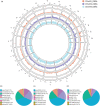DNA methylation and transcriptome analysis reveal epigenomic differences among three macaque species
- PMID: 38343783
- PMCID: PMC10853583
- DOI: 10.1111/eva.13604
DNA methylation and transcriptome analysis reveal epigenomic differences among three macaque species
Abstract
Macaques (genus Macaca) are the most widely distributed non-human primates, and their evolutionary history, gene expression profiles, and genetic differences have been extensively studied. However, the DNA methylomes of macaque species are not available in public databases, which hampers understanding of epigenetic differences among macaque species. Epigenetic modifications can potentially affect development, physiology, behavior, and evolution. Here, we investigated the methylation patterns of the Tibetan macaque (M. thibetana; TM), Chinese rhesus macaque (M. mulatta lasiota; CR), and crab-eating macaque (M. fascicularis; CE) through whole-genome bisulfite sequencing from peripheral blood. We compared genome-wide methylation site information for the three species. We identified 12,128 (CR vs. CE), 59,165 (CR vs. TM), and 39,751 (CE vs. TM) differentially methylated regions (DMRs) in the three macaques. Furthermore, we obtained the differentially expressed genes (DEGs) among the three macaque species. The differences between CR and CE were smaller at both the methylome and transcriptome levels than compared with TM (CR vs. TM and CE vs. TM). We also found a change in the density of single nucleotide mutations in DMRs relative to their flanking regions, indicating a potential mechanism through which genomic alterations may modulate methylation landscapes, thereby influencing the transcriptome. Functional enrichment analyses showed the DMR-related genes were enriched in developmental processes and neurological functions, such as the growth hormone-related pathway, insulin secretion pathway, thyroid hormone synthesis pathway, morphine addiction, and GABAergic synapses. These differences may be associated with variations in physiology and habitat among the macaques. Our study provides one of the first genome-wide comparisons of genetic, gene expression, and epigenetic variations across different macaques. Our results should facilitate further research on comparative genomic and genetic differences in macaque species.
Keywords: DNA methylation; Macaca; epigenetics; gene expression; neuro development.
© 2023 The Authors. Evolutionary Applications published by John Wiley & Sons Ltd.
Conflict of interest statement
The authors declare that they have no competing interests.
Figures





Similar articles
-
Whole-genome sequencing of tibetan macaque (Macaca Thibetana) provides new insight into the macaque evolutionary history.Mol Biol Evol. 2014 Jun;31(6):1475-89. doi: 10.1093/molbev/msu104. Epub 2014 Mar 18. Mol Biol Evol. 2014. PMID: 24648498 Free PMC article.
-
Comparative Methylome Analyses Identify Epigenetic Regulatory Loci of Human Brain Evolution.Mol Biol Evol. 2016 Nov;33(11):2947-2959. doi: 10.1093/molbev/msw176. Epub 2016 Aug 25. Mol Biol Evol. 2016. PMID: 27563052 Free PMC article.
-
Genome-wide DNA methylation analyses in the brain reveal four differentially methylated regions between humans and non-human primates.BMC Evol Biol. 2012 Aug 16;12:144. doi: 10.1186/1471-2148-12-144. BMC Evol Biol. 2012. PMID: 22899776 Free PMC article.
-
Age-related gene expression and DNA methylation changes in rhesus macaque.Genomics. 2020 Nov;112(6):5147-5156. doi: 10.1016/j.ygeno.2020.09.021. Epub 2020 Sep 11. Genomics. 2020. PMID: 32927008
-
Epigenomics in stress tolerance of plants under the climate change.Mol Biol Rep. 2023 Jul;50(7):6201-6216. doi: 10.1007/s11033-023-08539-6. Epub 2023 Jun 9. Mol Biol Rep. 2023. PMID: 37294468 Review.
Cited by
-
Genetic Architecture of Immune Cell DNA Methylation in the Rhesus Macaque.Mol Ecol. 2025 Aug;34(15):e17576. doi: 10.1111/mec.17576. Epub 2024 Nov 24. Mol Ecol. 2025. PMID: 39582237 Free PMC article.
-
Generic and queryable data integration schema for transcriptomics and epigenomics studies.Comput Struct Biotechnol J. 2024 Nov 19;23:4232-4241. doi: 10.1016/j.csbj.2024.11.022. eCollection 2024 Dec. Comput Struct Biotechnol J. 2024. PMID: 39660218 Free PMC article.
-
Epigenetic Diversity and the Evolutionary Potential of Wild Populations.Evol Appl. 2024 Oct 21;17(10):e70011. doi: 10.1111/eva.70011. eCollection 2024 Oct. Evol Appl. 2024. PMID: 39439434 Free PMC article.
References
-
- Angers, B. , Castonguay, E. , & Massicotte, R. (2010). Environmentally induced phenotypes and DNA methylation: How to deal with unpredictable conditions until the next generation and after. Molecular Ecology, 19(7), 1283–1295. - PubMed
-
- Bonkovsky, H. L. , Guo, J. T. , Hou, W. , Li, T. , Narang, T. , & Thapar, M. (2013). Porphyrin and heme metabolism and the porphyrias. Comprehensive Physiology, 3(1), 365–401. - PubMed
LinkOut - more resources
Full Text Sources

